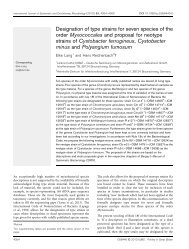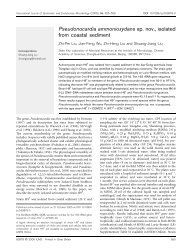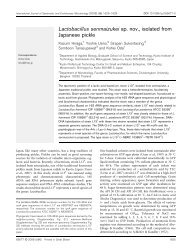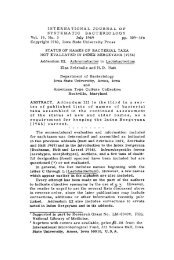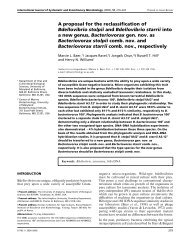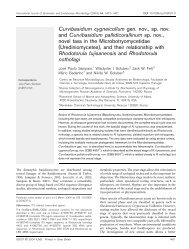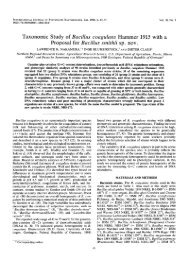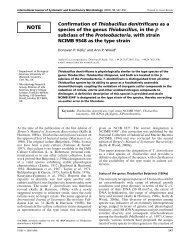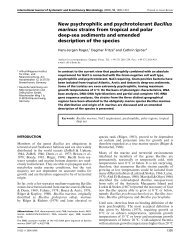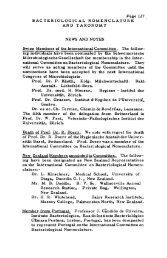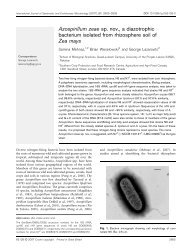Pichia insulana sp. nov., a novel cactophilic yeast from the Caribbean
Pichia insulana sp. nov., a novel cactophilic yeast from the Caribbean
Pichia insulana sp. nov., a novel cactophilic yeast from the Caribbean
Create successful ePaper yourself
Turn your PDF publications into a flip-book with our unique Google optimized e-Paper software.
International Journal of Systematic and Evolutionary Microbiology (2010), 60, 1001–1007 DOI 10.1099/ijs.0.014258-0<br />
Corre<strong>sp</strong>ondence<br />
Philip F. Ganter<br />
pganter@tnstate.edu<br />
INTRODUCTION<br />
The necrotic tissue of some cacti is home to a diverse <strong>yeast</strong><br />
community. Many of <strong>the</strong> <strong>sp</strong>ore-forming <strong>sp</strong>ecies produce<br />
ei<strong>the</strong>r two or four hat-shaped asco<strong>sp</strong>ores and are oligotrophic,<br />
assimilating fewer than 20 % of <strong>the</strong> carbon sources<br />
tested (Starmer et al., 1990). Similarities among many of <strong>the</strong><br />
<strong>sp</strong>ecies can make <strong>the</strong>m difficult to distinguish, and <strong>the</strong> first<br />
investigators classified many <strong>cactophilic</strong> strains as <strong>Pichia</strong><br />
membranifaciens, a <strong>sp</strong>ecies now known to be rare in this<br />
habitat (Heed et al., 1976). Repeated collection of variants<br />
<strong>from</strong> similar habitats led to <strong>the</strong> recognition that <strong>the</strong>y were<br />
separate <strong>sp</strong>ecies, and <strong>the</strong> habitat is now known to contain<br />
over a dozen endemic <strong>sp</strong>ecies with hat-shaped <strong>sp</strong>ores in at<br />
least three different genera (two endemic).<br />
A particularly subtle example of this similarity is <strong>Pichia</strong><br />
pseudocactophila. Cactophilic <strong>yeast</strong> identification is typically<br />
based on tests of a minimum of 63 physiological characters.<br />
<strong>Pichia</strong> cactophila, <strong>the</strong> worldwide dominant <strong>yeast</strong> <strong>from</strong> cactus<br />
tissue (in terms of frequency of isolation), grows strongly in<br />
13 physiological tests and variably in four o<strong>the</strong>rs (Starmer<br />
et al., 1978). P. cactophila was itself initially identified as P.<br />
membranifaciens. Sporogenous P. cactophila strains form two<br />
<strong>sp</strong>ores almost exclusively [see Shen & Lachance (1993) for an<br />
example of a four-<strong>sp</strong>ored P. cactophila]. Thisobservation,<strong>the</strong><br />
appearance of <strong>sp</strong>ores in colonies grown <strong>from</strong> single <strong>sp</strong>ores<br />
and <strong>the</strong> large size of <strong>the</strong> <strong>sp</strong>ores support <strong>the</strong> conclusion that<br />
Abbreviation: LSU, large subunit.<br />
The GenBank/EMBL/DDBJ accession number for <strong>the</strong> partial LSU<br />
rDNA sequence of strain TSU00-106.5 T is EU747339.<br />
<strong>Pichia</strong> <strong>insulana</strong> <strong>sp</strong>. <strong>nov</strong>., a <strong>nov</strong>el <strong>cactophilic</strong> <strong>yeast</strong><br />
<strong>from</strong> <strong>the</strong> <strong>Caribbean</strong><br />
Philip F. Ganter, 1 Gianluigi Cardinali 2 and Kyria Boundy-Mills 3<br />
1<br />
Department of Biology, Tennessee State University, 3500 John Merritt Blvd, Nashville, TN 37209,<br />
USA<br />
2 Dipartimento di Biologia Applicata, Sez. Microbiologia, Borgo 20 Giugno 74, I-06121 Perugia, Italy<br />
3<br />
Department of Food Science and Technology, University of California Davis, One Shields Ave,<br />
Davis, CA 95616, USA<br />
A <strong>nov</strong>el <strong>sp</strong>ecies of ascomycetous <strong>yeast</strong>, <strong>Pichia</strong> <strong>insulana</strong> <strong>sp</strong>. <strong>nov</strong>., is described <strong>from</strong> necrotic tissue<br />
of columnar cacti on <strong>Caribbean</strong> islands. P. <strong>insulana</strong> is closely related to and phenotypically very<br />
similar to <strong>Pichia</strong> cactophila and <strong>Pichia</strong> pseudocactophila. There are few distinctions between<br />
<strong>the</strong>se taxa besides <strong>sp</strong>ore type, host preference and locality. Sporogenous strains of P. <strong>insulana</strong><br />
that produce asci with four hat-shaped <strong>sp</strong>ores have been found only on Curaçao, whereas <strong>the</strong>re<br />
was no evidence of <strong>sp</strong>orogenous P. cactophila <strong>from</strong> that island. In addition, sequences of <strong>the</strong><br />
D1/D2 fragment of <strong>the</strong> large-subunit rDNA <strong>from</strong> 12 Curaçao strains showed consistent<br />
differences <strong>from</strong> <strong>the</strong> sequences of <strong>the</strong> type strains of P. cactophila and P. pseudocactophila. The<br />
type strain of P. <strong>insulana</strong> is TSU00-106.5 T (5CBS 11169 T 5UCD-FST 09-160 T ).<br />
<strong>the</strong> <strong>sp</strong>ores are diploid. Some of <strong>the</strong> strains collected <strong>from</strong> cacti<br />
of <strong>the</strong> Pachycereinae <strong>from</strong> <strong>the</strong> Sonoran Desert had asci with<br />
four smaller <strong>sp</strong>ores. Although rare in <strong>the</strong>ir only known<br />
habitat, <strong>the</strong> four-<strong>sp</strong>ored strains proved to represent a separate<br />
<strong>sp</strong>ecies, subsequently named P. pseudocactophila (Holzschu<br />
et al., 1983). Determination of <strong>sp</strong>ecific status for P.<br />
pseudocactophila was based on low DNA–DNA relatedness<br />
with P. cactophila and allozyme frequency variation.<br />
Subsequent sequencing of <strong>the</strong> D1/D2 fragment of <strong>the</strong> largesubunit<br />
(LSU) rDNA also found consistent differences<br />
between <strong>the</strong> two <strong>sp</strong>ecies (Kurtzman & Robnett, 1998).<br />
There is no physiological character known that will separate<br />
<strong>the</strong> two <strong>sp</strong>ecies consistently, and <strong>sp</strong>ore number and source<br />
(location and host plant) of <strong>the</strong> strain remain <strong>the</strong> accepted<br />
way to differentiate <strong>the</strong> two <strong>sp</strong>ecies without resorting to DNA<br />
sequencing. A potential problem for identification lies in <strong>the</strong><br />
tendency of <strong>cactophilic</strong> <strong>yeast</strong> <strong>sp</strong>ecies to have non-<strong>sp</strong>orulating<br />
strains, as is known for P. cactophila (described as an<br />
anamorphic <strong>sp</strong>ecies, Candida cactophila). It is not known<br />
whe<strong>the</strong>r P. pseudocactophila has non-<strong>sp</strong>orulating lineages.<br />
In early 2000, <strong>yeast</strong>s were isolated <strong>from</strong> necrotic cacti<br />
growing on <strong>the</strong> island of Curaçao, one of <strong>the</strong> Ne<strong>the</strong>rlands<br />
Antilles in <strong>the</strong> <strong>Caribbean</strong>. The dominant <strong>yeast</strong> was<br />
physiologically identical to P. cactophila, but all <strong>sp</strong>orulating<br />
strains produced asci with four small hat-shaped <strong>sp</strong>ores.<br />
Here, we present data that demonstrate that <strong>the</strong> strains<br />
<strong>from</strong> Curaçao are nei<strong>the</strong>r P. cactophila nor P. pseudocactophila,<br />
and we propose <strong>the</strong> name <strong>Pichia</strong> <strong>insulana</strong> <strong>sp</strong>. <strong>nov</strong>. for<br />
<strong>the</strong> new taxon. A search of strains housed at <strong>the</strong> Phaff Yeast<br />
Collection at <strong>the</strong> University of California Davis revealed<br />
014258 G 2010 IUMS Printed in Great Britain 1001
P. F. Ganter, G. Cardinali and K. Boundy-Mills<br />
several strains <strong>from</strong> <strong>the</strong> <strong>Caribbean</strong> region that had<br />
originally been identified as P. cactophila but did not have<br />
<strong>the</strong> expected partial LSU rDNA sequence, and we added<br />
those strains to this study.<br />
METHODS<br />
Strain isolation and determination of physiological abilities.<br />
Strains used in this study are listed in Table 1. Samples of necrotic<br />
cactus stem tissue were collected <strong>from</strong> five sites on Curaçao in January<br />
2000. Methods for isolation of <strong>yeast</strong> <strong>from</strong> cactus samples have been<br />
described by Starmer & Phaff (1983). Morphological and physiological<br />
tests were done as described by Yarrow (1998), as modified by Lachance<br />
et al. (1988). Over 380 strains were isolated <strong>from</strong> 49 rots and 99 of <strong>the</strong>se<br />
had physiological profiles consistent with P. cactophila. Of those 99<br />
strains, 24 produced four-<strong>sp</strong>ored asci, one produced asci with ei<strong>the</strong>r<br />
two or three <strong>sp</strong>ores and no asci were detected <strong>from</strong> <strong>the</strong> remaining 74<br />
strains. Asci <strong>from</strong> strain TSU00-106.5 T (<strong>the</strong> designated type strain)<br />
were dissected and mating types were determined for all <strong>sp</strong>ore clones.<br />
In addition, matings were attempted between P. <strong>insulana</strong> mating types,<br />
<strong>the</strong> a<strong>sp</strong>orogenous strains of P. <strong>insulana</strong> strains <strong>from</strong> Curaçao, <strong>the</strong> six<br />
strains identified as P. cactophila <strong>from</strong> <strong>the</strong> UC Davis collection and <strong>the</strong><br />
mating types of P. pseudocactophila.<br />
rDNA sequence determination. LSU rDNA sequences were<br />
amplified using primers NL1 and NL4 (Kurtzman & Robnett, 1998)<br />
with <strong>the</strong> following PCR program: 95 uC for 2 min, 36 cycles<br />
consisting of 1 min at 94 uC, 1 min at 52 uC and 2 min at 72 uC<br />
and a final extension of 8 min at 72 uC. After purification with <strong>the</strong> Jet<br />
Quick kit (Genomed GmbH), sequencing was carried out by <strong>the</strong><br />
Table 1. Strain numbers, collection location and host of sequenced P. <strong>insulana</strong> <strong>sp</strong>. <strong>nov</strong>. isolates<br />
MWG service (MWG Biotech AG). Electrophoregrams were read with<br />
TraceViewer (http://www.codoncode.com).<br />
Phylogenetic analysis of <strong>the</strong> sequences. The analysis involved 12<br />
P. <strong>insulana</strong> sequences (Table 1) plus <strong>the</strong> published sequences for <strong>the</strong> type<br />
strains of P. cactophila and o<strong>the</strong>r closely related strains as determined<br />
through rDNA sequence similarity (<strong>from</strong> Kurtzman & Robnett, 1998).<br />
The clade is composed of <strong>cactophilic</strong> <strong>sp</strong>ecies plus <strong>Pichia</strong> kudriavzevii<br />
(formerly Issatchenkia occidentalis; Kurtzmanet al., 2008), <strong>Pichia</strong> nakasei<br />
and Candida incon<strong>sp</strong>icua [<strong>the</strong> sister taxon of P. cactophila in Kurtzman &<br />
Robnett (1998)]. P. nakasei was <strong>the</strong> outgroup for this analysis. There are<br />
now multiple ways to align nucleotide sequences and to construct a<br />
phylogeny based on <strong>the</strong> aligned sequences. Ra<strong>the</strong>r than employ a single<br />
combination of alignment/phylogeny construction algorithms and be<br />
subject to <strong>the</strong> assumptions of both, we chose to employ multiple<br />
alignment/phylogeny construction pairings and to report <strong>the</strong> results<br />
common to all. Sequences were aligned using CLUSTAL_X, DIALIGN 2<br />
(which maximizes <strong>the</strong> number of aligned segments; Morgenstern, 1999)<br />
and SOAP (which uses CLUSTAL_X as its alignment algorithm but varies <strong>the</strong><br />
gap and extension penalties and presents a consensus alignment;<br />
Löytynoja & Milinkovitch, 2001). Phylogenies involving just <strong>the</strong> unique<br />
P. <strong>insulana</strong> sequences plus <strong>the</strong> P. cactophila and C. incon<strong>sp</strong>icua type strain<br />
sequences were constructed using PAUP* (Swofford, 1999) under a variety<br />
of tree comparison criteria, including parsimony (default settings except<br />
that gaps were treated as both missing data and a separate character<br />
state), neighbour-joining and maximum-likelihood (using default PAUP*<br />
settings). Neighbour-joining phylogenies were based on uncorrected p,<br />
F84, Tamura–Nei, Tajima–Nei and maximum-likelihood Jukes–Cantor<br />
distances. A second phylogeny was constructed with <strong>the</strong> addition of 10<br />
more D1/D2 fragment sequences <strong>from</strong> type strains of <strong>sp</strong>ecies in <strong>the</strong> same<br />
clade as P. cactophila (Kurtzman & Robnett, 1998). The increase in<br />
Collections: TSU, first author’s culture collection at Tennessee State University, Nashville, TN, USA; UCD-FST, Phaff Yeast Culture Collection at<br />
<strong>the</strong> University of California, Davis, CA, USA. Yeasts with TSU identification numbers are <strong>from</strong> sites on <strong>the</strong> island of Curaçao, Ne<strong>the</strong>rlands Antilles.<br />
Strains with UCD-FST numbers were originally identified as (possibly) P. cactophila but have LSU rDNA sequences similar to those of P. <strong>insulana</strong>.<br />
Spore data were obtained <strong>from</strong> strains on YM plates inoculated at <strong>the</strong> same time that <strong>the</strong> identification series of plates was inoculated. The search<br />
for <strong>sp</strong>ores was done at or after 5 days post-inoculation.<br />
Strain Location Host* Spores<br />
TSU00-101.1 Weg naar Westpunt Stenocereus griseus Two- and three-<strong>sp</strong>ored asci<br />
TSU00-106.5 T<br />
Weg naar Westpunt Cereus repandus Four-<strong>sp</strong>ored asci<br />
TSU00-115.4 Weg naar Westpunt Stenocereus griseus None<br />
TSU00-125.3 Wacawa Opuntia <strong>sp</strong>. None<br />
TSU00-133.1 Wacawa Opuntia <strong>sp</strong>. None<br />
TSU00-135.2A Wacawa Opuntia <strong>sp</strong>. Four-<strong>sp</strong>ored asci<br />
TSU00-139.4 Savonet Cereus repandus Four-<strong>sp</strong>ored asci<br />
TSU00-142.6 Savonet Stenocereus griseus None<br />
TSU00-144.2 Savonet Stenocereus griseus None<br />
TSU00-149.3 Westpunt Stenocereus griseus None<br />
TSU00-151.3 Westpunt Stenocereus griseus Four-<strong>sp</strong>ored asci<br />
TSU00-153.2A Westpunt Stenocereus griseus None<br />
UCD-FST 81-111 Coastal Venezuela Stenocereus griseus None<br />
UCD-FST 82-472.1 Hi<strong>sp</strong>aniola Pilosocereus <strong>sp</strong>. None<br />
UCD-FST 82-527.3 Hi<strong>sp</strong>aniola Stenocereus hystrix None<br />
UCD-FST 82-608.1 British Virgin Islands Pilosocereus royenii None<br />
UCD-FST 83-1065.2 Cayman Islands Opuntia stricta None<br />
UCD-FST 83-1117.1 Cayman Islands Opuntia stricta fruit None<br />
*Stenocereus griseus5Lemairerocereus griseus; Opuntia <strong>sp</strong>. is probably O. caracassana; Pilosocereus <strong>sp</strong>. is probably P. royenii.<br />
1002 International Journal of Systematic and Evolutionary Microbiology 60
computation time resulting <strong>from</strong> <strong>the</strong> addition of taxa meant that<br />
maximum-likelihood analysis was dropped <strong>from</strong> <strong>the</strong> larger analysis, but<br />
<strong>the</strong> results reported here are those common to all algorithms used.<br />
Bootstrap values were determined using only distance and parsimony<br />
criteria.<br />
RESULTS<br />
Sequencing of <strong>the</strong> rDNA <strong>from</strong> <strong>the</strong> 12 strains produced<br />
eight unique sequences (<strong>the</strong>re were four pairs of identical<br />
sequences: TSU00-101.1/TSU00-125.3, TSU00-106.5 T /<br />
TSU00-139.4, TSU00-115.4/TSU00-151.3 and TSU00-<br />
135.2A/TSU00-153.2). Among <strong>the</strong> eight unique sequences,<br />
<strong>the</strong>re were no indels, but <strong>the</strong>y differed at a mean of 3.15<br />
sites (ranging <strong>from</strong> 1 to 6 sites). Comparison of <strong>the</strong><br />
sequences to <strong>the</strong> P. cactophila and P. pseudocactophila<br />
sequences revealed five indels, with <strong>the</strong> longest being a 3 bp<br />
indel unique to P. pseudocactophila. Only one indel was<br />
unique to P. <strong>insulana</strong>. There were a mean of 9.88<br />
substitutions between <strong>the</strong> eight sequences <strong>from</strong> P. <strong>insulana</strong><br />
strains and <strong>the</strong> sequence of <strong>the</strong> type strain of P. cactophila<br />
(ranging <strong>from</strong> 8 to 13) and a mean of 18.25 substitutions<br />
for <strong>the</strong> comparison between P. <strong>insulana</strong> and <strong>the</strong> type strain<br />
of P. pseudocactophila (ranging <strong>from</strong> 16 to 21). The six<br />
strains <strong>from</strong> <strong>the</strong> UC Davis collection that were not<br />
collected on Curaçao all had D1/D2 rDNA sequences<br />
identical to that of TSU00-125.3 and TSU00-101.1 (<strong>the</strong>se<br />
six sequences were not deposited in GenBank or added to<br />
<strong>the</strong> dataset used to construct phylogenies). This establishes<br />
that <strong>the</strong> six strains (all a<strong>sp</strong>orogenous) <strong>from</strong> <strong>the</strong> UC<br />
Davis collection are members of P. <strong>insulana</strong>, not P.<br />
cactophila.<br />
Analysis of <strong>the</strong> set of eight D1/D2 LSU rDNA sequences<br />
<strong>from</strong> P. <strong>insulana</strong> and <strong>the</strong> type strains of P. cactophila and C.<br />
incon<strong>sp</strong>icua produced a tree that placed all 12 strains of P.<br />
<strong>insulana</strong> <strong>from</strong> Curaçao in a single clade. The P. <strong>insulana</strong><br />
clade was joined to a second clade containing both P.<br />
cactophila and C. incon<strong>sp</strong>icua. Both <strong>the</strong> P. <strong>insulana</strong> and <strong>the</strong> P.<br />
cactophila/C. incon<strong>sp</strong>icua clades had bootstrap values of<br />
nearly 100 % (for parsimony as well as distance criteria),<br />
supporting <strong>the</strong> conclusion that P. <strong>insulana</strong> and P. cactophila<br />
are separate taxa. The essential topology of <strong>the</strong> tree did not<br />
differ among algorithms and <strong>the</strong> bootstrap values described<br />
above were common to all analyses (some minor rearrangements<br />
were found within <strong>the</strong> P. <strong>insulana</strong> clade). When <strong>the</strong><br />
type strains <strong>from</strong> related <strong>sp</strong>ecies were included in <strong>the</strong><br />
analysis, <strong>the</strong> topology of <strong>the</strong> tree and bootstrap analysis once<br />
again supported <strong>the</strong> separation of <strong>the</strong> P. <strong>insulana</strong> and P.<br />
cactophila/C. incon<strong>sp</strong>icua clades (Fig. 1). As in <strong>the</strong> case of <strong>the</strong><br />
smaller dataset, <strong>the</strong> optimal tree or trees found were<br />
identical in topology except for minor rearrangements<br />
within <strong>the</strong> P. <strong>insulana</strong> clade irre<strong>sp</strong>ective of which treebuilding<br />
algorithm was used, although <strong>the</strong> actual tree<br />
presented is based on distance. Bootstrap values for<br />
parsimony were also similar to those presented in Fig. 1.<br />
Ano<strong>the</strong>r topological feature common to all trees is <strong>the</strong> small<br />
clade consisting of strains TSU00-142.6 and TSU00-144.2,<br />
Cactophilic <strong>Pichia</strong> <strong>insulana</strong> <strong>sp</strong>. <strong>nov</strong>., <strong>from</strong> <strong>the</strong> <strong>Caribbean</strong><br />
Fig. 1. Neighbour-joining tree based on Tajima–Nei distances<br />
calculated <strong>from</strong> aligned D1/D2 LSU rDNA sequences representing<br />
<strong>the</strong> eight unique P. <strong>insulana</strong> sequences and sequences <strong>from</strong><br />
related type strains. GenBank accession numbers are given.<br />
Bootstrap values (%) are placed on or at <strong>the</strong> most convenient end<br />
of <strong>the</strong> branch leading to <strong>the</strong> clade to which <strong>the</strong> value pertains<br />
(values below 70 % omitted). Bar, 0.01 substitutions per site.<br />
both <strong>from</strong> Stenocereus griseus rots at <strong>the</strong> Savonet site on<br />
Curaçao. Bootstrap support varied <strong>from</strong> 76 to 88 %. Nei<strong>the</strong>r<br />
strain produced <strong>sp</strong>ores. Given <strong>the</strong> small number of strains<br />
and <strong>the</strong> slight magnitude of <strong>the</strong> variation involved, it is<br />
impossible to come to any conclusions about <strong>the</strong> taxonomic<br />
importance of this clade.<br />
Latin diagnosis of <strong>Pichia</strong> <strong>insulana</strong> Ganter,<br />
Cardinali et Boundy-Mills <strong>sp</strong>. <strong>nov</strong>.<br />
In YM (Difco) liquido post dies 3 in 30 uC, cellulae rotundae<br />
vel ovoideae, 1.3–2.562.5–5.0 mm. In agaro farinae Zea mays<br />
post dies 10 pseudomycelium paucum. Cultura in agaro-malti<br />
post dies 21 in 25 uC cana-cremea, butyrosa vel mollis, glabra,<br />
nitida, margine glabro. In agaro YM (Difco) post 6–14 dies<br />
asci ovoidei, 4asco<strong>sp</strong>oras continentes. Fermentatio fere nulla;<br />
in tribus stipitibus exigua glucosi fermentatio. Glucosum,<br />
ethanolum, D-glucosamina, acidum lacticum, succinicum<br />
acidum, citricum acidum et malicum acidum assimilantur.<br />
Lente vel exigue crescit in glicerolo. Non crescit in D-galactoso,<br />
L-sorboso, maltoso, sucroso, cellobioso, trehaloso, lactoso,<br />
melibioso, raffinosio, melezitoso, inulino, solubile amylo, Dxyloso,<br />
D- vel L-arabinoso, D-riboso, L-rhamnoso, erythritolo,<br />
adonitolo (ribitolo), dulcitolo (galactitolo), D-mannitolo, Dsorbitolo<br />
(D-glucitolo), methyl-a-glucosido, salicino, gluconod-lactono,<br />
5keto-gluconato, inositolo, N-acetylglucosamino,<br />
glucuronico acido, hexadecano, methanolo, ethyl-acetato, 2propanolo,<br />
vel acetono. Crescere potest in 42 uC, et in 5%<br />
NaCl/0.5 % glucoso, sed non in 10 % NaCl/0.5 % glucoso. Non<br />
http://ijs.sgmjournals.org 1003
P. F. Ganter, G. Cardinali and K. Boundy-Mills<br />
crescit in digitonino et in cycloheximido at 0.1 p.p.m.<br />
Habitatio in cacti tribus Opuntieae, stipitibus subtribus<br />
Stenocereinae et stipitibus tribus Cereeae.<br />
Typus: stirps TSU00-106.5 T ex tabidosus sacculis cacti Cereus<br />
repandus isolata est. Stirps TSU00-106.5 T in collectione<br />
zymotica Centraalbureau voor Schimmelcultures, Delphi<br />
Batavorum sub no. CBS 11169 T et Phaff Yeast Culture<br />
Collection, Davis, CA, USA, sub no. UCD-FST 09-160 T<br />
deposita est.<br />
Description of <strong>Pichia</strong> <strong>insulana</strong> Ganter, Cardinali &<br />
Boundy-Mills <strong>sp</strong>. <strong>nov</strong>.<br />
<strong>Pichia</strong> <strong>insulana</strong> (in.su.la9na. L. fem. adj. <strong>insulana</strong> of or<br />
belonging to an island, referring to <strong>the</strong> isolation of strains<br />
<strong>from</strong> <strong>the</strong> island of Curaçao).<br />
Carbon sources assimilated are glucose, ethanol, Dglucosamine,<br />
lactic acid, succinic acid, citric acid and<br />
malic acid. Growth is delayed on glycerol and sometimes<br />
weak. None of <strong>the</strong> known strains grows on D-galactose, Lsorbose,<br />
maltose, sucrose, cellobiose, trehalose, lactose,<br />
melibiose, raffinose, melezitose, inulin, soluble starch, Dxylose,<br />
D- orL-arabinose, D-ribose, L-rhamnose, erythritol,<br />
adonitol (ribitol), dulcitol (galactitol), D-mannitol, Dsorbitol<br />
(D-glucitol), methyl a-glucoside, salicin, gluconod-lactone,<br />
5-ketogluconate, inositol, N-acetylglucosamine,<br />
glucuronic acid, hexadecane, methanol, ethyl acetate, 2propanol<br />
or acetone. Most strains demonstrate no ability<br />
to ferment, but three strains ferment glucose weakly (some<br />
gas in <strong>the</strong> Durham tubes) after 14 days. All strains grow at<br />
42 uC and on 5 % NaCl/0.5 % glucose medium, but not at<br />
10 % NaCl. The only nitrogen source assimilated strongly is<br />
ethylamine, but most strains grow weakly on lysine.<br />
Nitrogen sources not assimilated include KNO3 and<br />
KNO2. All known strains are susceptible to digitonin and<br />
0.1 p.p.m. cycloheximide. No tested strain shows any killer<br />
activity against Candida glabrata strain Y-55 (Starmer et<br />
al., 1987). After 3 days growth on YM agar (Difco), cells<br />
are <strong>sp</strong>herical to ellipsoid and approximately 2–364–7 mm<br />
(Fig. 2). Short pseudohyphae are rare on cornmeal agar<br />
after 10 days of growth. Three days’ growth in liquid YM<br />
medium (Difco) at 30 uC produces <strong>sp</strong>herical to ovoid cells,<br />
1.3–2.562.5–5 mm. Colonies grown on malt agar are<br />
cream-coloured, with a smooth, glistening surface and an<br />
even margin. Spores can be observed on YM agar (Difco)<br />
after 6–14 days. Six asci <strong>from</strong> strain TSU00-106.5 T were<br />
dissected, which yielded 18 <strong>sp</strong>ore clones. All four <strong>sp</strong>ores<br />
germinated <strong>from</strong> three asci but only two germinated <strong>from</strong><br />
<strong>the</strong> remaining three asci. Mating among <strong>the</strong> <strong>sp</strong>ore clones<br />
confirmed that <strong>the</strong> <strong>sp</strong>ecies is heterothallic, as all three<br />
complete asci segregated in <strong>the</strong> expected 2h + :2h 2 ratio<br />
(h + and h 2 symbolizing opposite mating types). Once<br />
opposite mating types are mixed, changes in <strong>the</strong> shape of<br />
vegetative cells (<strong>the</strong> appearance of subequatorial bulges<br />
characteristic of shmooing) and conjugation tube formation<br />
are observed within 1–7 days (reasons for <strong>the</strong> wide<br />
variation in <strong>the</strong> re<strong>sp</strong>onse time are not known). Spore<br />
Fig. 2. Cells and dehisced asci of <strong>Pichia</strong> <strong>insulana</strong> <strong>sp</strong>. <strong>nov</strong>.<br />
TSU00-106.5 T after 8 days on YM agar. (a) Vegetative cells; (b, c)<br />
isolated conjugants with conjugation tube visible; (d–h) dehisced<br />
asci with four hat-shaped <strong>sp</strong>ores.<br />
clones TSU00-106.5V and TSU00-106.5W were designated<br />
mating types h + and h 2 , re<strong>sp</strong>ectively. No mating between<br />
ei<strong>the</strong>r P. <strong>insulana</strong> mating type and <strong>the</strong> a<strong>sp</strong>orogenous strains<br />
<strong>from</strong> Curaçao, <strong>the</strong> six UC Davis strains or <strong>the</strong> mating types<br />
of P. pseudocactophila produces <strong>sp</strong>ores or gives any<br />
indication (shmooing or conjugation tube formation) of<br />
sexual activity.<br />
Strain TSU00-106.5 T (5CBS-11169 T 5UCD-FST 09-<br />
160 T ), collected <strong>from</strong> a rot pocket in a Cereus repandus<br />
cactus on <strong>the</strong> island of Curaçao, is <strong>the</strong> type strain. The<br />
mating type <strong>sp</strong>ore clones of TSU00-106.5 T are deposited at<br />
<strong>the</strong> Phaff Yeast Culture Collection, University of California<br />
Davis, Davis, CA, USA, as UCD-FST 09-161 (h+ clone)<br />
and UCD-FST 09-162 (h2 clone).<br />
1004 International Journal of Systematic and Evolutionary Microbiology 60
Table 2. Composition of <strong>the</strong> <strong>cactophilic</strong> <strong>yeast</strong> community found on Curaçao<br />
Opuntia <strong>sp</strong>. was probably Opuntia caracassana. Sites: Hat, Hato Airport; Sav, Savonet; Wac, Wacawa; WNW, Weg naar Westpunt; Wes, Westpunt.<br />
Numbers given for <strong>yeast</strong> <strong>sp</strong>ecies are <strong>the</strong> number of rots in which that <strong>sp</strong>ecies was found, and should be compared with <strong>the</strong> total number of rots to<br />
assess how common a <strong>sp</strong>ecies was at a particular collection site. Overall proportions of rots containing a given <strong>sp</strong>ecies are given on <strong>the</strong> right.<br />
Yeast <strong>sp</strong>ecies Opuntia <strong>sp</strong>. Stenocereus griseus Cereus repandus Total<br />
DISCUSSION<br />
Wac Sav Hat WNW Wac Sav Wes WNW Sav Wes n %<br />
<strong>Pichia</strong> <strong>insulana</strong> <strong>sp</strong>. <strong>nov</strong>. 11 1 1 5 1 5 4 11 3 1 43 32<br />
Galactomyces geotrichum 9 2 0 1 0 1 2 2 1 0 18 14<br />
Candida sonorensis 3 1 0 2 0 3 1 1 2 0 13 10<br />
<strong>Pichia</strong> kluyveri 0 1 0 1 0 2 1 4 1 0 10 8<br />
Starmera ‘curacao’ 3 2 0 1 0 1 0 1 0 0 8 6<br />
<strong>Pichia</strong> deserticola 0 0 1 0 0 2 2 2 0 0 7 5<br />
Clavi<strong>sp</strong>ora opuntiae 1 0 0 0 0 0 2 2 1 0 6 5<br />
Sporopachydermia cereana<br />
complex<br />
0 0 0 0 0 2 0 2 1 0 5 4<br />
Rhodotorula graminis 1 0 0 0 0 0 0 2 0 0 3 2<br />
Cryptococcus albidus 0 0 0 0 0 0 1 1 0 0 2 2<br />
Geotrichum clavatum 1 0 0 0 0 1 0 0 0 0 2 2<br />
Proto<strong>the</strong>ca <strong>sp</strong>. 0 0 0 0 0 1 1 0 0 0 2 2<br />
Aureobasidium pullulans 0 0 0 0 0 0 0 1 0 0 1 1<br />
Candida sonorensis-like 0 0 0 0 0 0 0 0 1 0 1 1<br />
<strong>Pichia</strong> mexicana curacao 1 0 0 0 0 0 0 0 0 0 1 1<br />
Rhodotorula minuta 0 0 0 0 0 1 0 0 0 0 1 1<br />
Unknown curacao 2 0 0 0 0 0 1 1 2 1 0 5 4<br />
Unknown curacao 7 1 0 0 0 0 0 0 1 0 0 2 2<br />
Unknown curacao 6 0 0 0 0 0 0 1 0 0 0 1 1<br />
Unknown curacao 8 1 0 0 0 0 0 0 0 0 0 1 1<br />
Unknown curacao 10<br />
Site parameters<br />
1 0 0 0 0 0 0 0 0 0 1 1<br />
Mean rot pH 7.6 7.0 8.3 6.1 8.5 6.7 6.5 6.5 6.3 4.5 – –<br />
Mean <strong>sp</strong>ecies per rot 2.36 3.50 2.00 1.67 1.00 4.00 3.20 2.91 3.67 1.00 – –<br />
Number of rots 14 2 1 6 1 5 5 11 3 1 – –<br />
Total isolates 33 7 2 10 1 20 16 32 11 1 133 –<br />
The addition of P. <strong>insulana</strong> to <strong>the</strong> <strong>cactophilic</strong> <strong>yeast</strong>s is<br />
consistent with our changing perceptions of <strong>the</strong> systematics<br />
of this interesting <strong>yeast</strong> community, although it<br />
raises questions about our perceptions of <strong>the</strong> community’s<br />
ecology. As mentioned in <strong>the</strong> introduction, our<br />
concept of <strong>the</strong> <strong>cactophilic</strong> <strong>yeast</strong> community has changed<br />
since <strong>the</strong> inception of its scientific study. The number of<br />
endemic <strong>sp</strong>ecies has grown steadily, mostly through<br />
examination of clusters of strains exhibiting undescribed<br />
physiological profiles. As many of <strong>the</strong> <strong>sp</strong>ecies were<br />
originally classified as members of <strong>the</strong> genus <strong>Pichia</strong>, it<br />
appearedatonetimethatanoligotrophicmemberof<br />
that genus had undergone a minor radiation upon<br />
colonizing cacti, a ra<strong>the</strong>r recent plant family (Starmer et<br />
al., 1986). However, molecular evidence does not<br />
support this scenario, and <strong>the</strong> present picture is of<br />
several invasions by <strong>yeast</strong> lineages <strong>from</strong> separate clades<br />
within <strong>the</strong> Saccharomycetales (Starmer et al., 2003).<br />
Given <strong>the</strong> diverse origins of <strong>the</strong> <strong>yeast</strong>s in <strong>the</strong> habitat, <strong>the</strong><br />
Cactophilic <strong>Pichia</strong> <strong>insulana</strong> <strong>sp</strong>. <strong>nov</strong>., <strong>from</strong> <strong>the</strong> <strong>Caribbean</strong><br />
<strong>yeast</strong>s that arrived became isolated <strong>from</strong> <strong>the</strong>ir relatives<br />
and many have undergone subsequent <strong>sp</strong>eciation within<br />
<strong>the</strong> habitat.<br />
Originally, <strong>the</strong> <strong>cactophilic</strong> <strong>sp</strong>ecies appeared to exhibit two<br />
distinct geographical distributions: those with restricted<br />
local distributions and those with global distributions.<br />
Most <strong>cactophilic</strong> <strong>sp</strong>ecies belonged to <strong>the</strong> local group.<br />
For instance, Candida orba has been found only in <strong>the</strong><br />
region around Brisbane, Australia (Starmer et al., 2001).<br />
Starmera and Phaffomyces are both endemic genera that<br />
consist of locally distributed <strong>sp</strong>ecies (Yamada et al., 1999).<br />
Most local <strong>sp</strong>ecies are sexual. Three asexual (or effectively<br />
asexual) <strong>sp</strong>ecies made up <strong>the</strong> global group: P. cactophila,<br />
Cryptococcus cereanus and Candida sonorensis. Theglobal<br />
<strong>sp</strong>ecies were often <strong>the</strong> most commonly isolated <strong>yeast</strong>s<br />
within a given habitat, so that <strong>the</strong>re seemed little<br />
advantage to local <strong>sp</strong>ecialization for <strong>the</strong> global subset<br />
of <strong>cactophilic</strong> <strong>yeast</strong>s, in contrast to those with local<br />
distributions, many of which do <strong>sp</strong>ecialize yet never<br />
dominate <strong>the</strong>ir communities.<br />
http://ijs.sgmjournals.org 1005
P. F. Ganter, G. Cardinali and K. Boundy-Mills<br />
This picture of three globally dominant <strong>sp</strong>ecies began to<br />
change with <strong>the</strong> discovery of sexuality in C. cereanus,<br />
which became Sporopachydermia cereana (Rodrigues De<br />
Miranda, 1978) not long after it was first described. C.<br />
cereanus strains (often referred to in publications as<br />
belonging to <strong>the</strong> C. cereanus ‘complex’) were noted for<br />
<strong>the</strong>ir physiological variability (Lachance, 1998; and our<br />
unpublished data), and reassessment of this variability and<br />
examination of partial LSU rDNA sequences revealed this<br />
global <strong>sp</strong>ecies to be ano<strong>the</strong>r example of a cluster of related<br />
<strong>cactophilic</strong> <strong>sp</strong>ecies (Lachance et al., 2001). Much less<br />
physiological variability has been reported <strong>from</strong> <strong>the</strong> two<br />
remaining global <strong>sp</strong>ecies, even when considerable local<br />
genetic variability was uncovered (Ganter & Quarles,<br />
1997; Ganter et al., 2004). The description of P. <strong>insulana</strong>,<br />
along with <strong>the</strong> previous description of P. pseudocactophila,<br />
makes it possible that <strong>the</strong> most ‘global’ of <strong>the</strong> global<br />
<strong>sp</strong>ecies, P. cactophila, is also a cluster of local, cryptic,<br />
endemic <strong>sp</strong>ecies. An observation and an absence of<br />
observations support this possibility. Some physiological<br />
variation has been found in strains collected <strong>from</strong> nor<strong>the</strong>astern<br />
Brazil, and <strong>the</strong>y may represent ano<strong>the</strong>r <strong>sp</strong>ecies in<br />
<strong>the</strong> complex. The absence of observations results <strong>from</strong> <strong>the</strong><br />
fact that strains identified as P. cactophila <strong>from</strong> most<br />
regions have not yet been examined for consistent patterns<br />
of molecular variation, a means of uncovering cryptic<br />
<strong>sp</strong>eciation when standard identification methods do not<br />
suffice. The global <strong>sp</strong>ecies group may not survive close<br />
scrutiny.<br />
Comparison of <strong>the</strong> distributions of P. <strong>insulana</strong>, P.<br />
cactophila and P. pseudocactophila raises questions that<br />
illustrate our lack of understanding of <strong>yeast</strong> ecology. All are<br />
restricted to <strong>the</strong> <strong>cactophilic</strong> habitat and are phenotypically<br />
indistinguishable. With this degree of overlap, how do all<br />
three coexist within this habitat? There is no consistent<br />
pattern to <strong>the</strong> interactions between <strong>the</strong> wide<strong>sp</strong>read,<br />
generalist <strong>sp</strong>ecies (P. cactophila) and <strong>the</strong> sexual <strong>sp</strong>ecies<br />
with restricted distributions and/or host ranges. All of <strong>the</strong><br />
sequences <strong>from</strong> strains collected on Curaçao belonged to<br />
<strong>the</strong> P. <strong>insulana</strong> clade, whe<strong>the</strong>r or not <strong>the</strong>y produced <strong>sp</strong>ores,<br />
so it is likely that P. cactophila is not found on Curaçao,<br />
making it <strong>the</strong> first <strong>cactophilic</strong> community investigated that<br />
does not include P. cactophila. P. cactophila is found<br />
throughout <strong>the</strong> <strong>Caribbean</strong> and in Venezuela, so chance<br />
does not seem a likely reason for its absence <strong>from</strong> Curaçao.<br />
The <strong>cactophilic</strong> <strong>yeast</strong> community of Curaçao was dominated<br />
by P. <strong>insulana</strong> (Table 2), much in <strong>the</strong> way that P.<br />
cactophila dominates <strong>the</strong> <strong>cactophilic</strong> <strong>yeast</strong> community at<br />
many locales (Starmer et al., 1990). The six strains found in<br />
<strong>the</strong> Phaff Yeast Culture Collection show that P. <strong>insulana</strong> is<br />
not confined to Curaçao, but that it is not <strong>the</strong> dominant<br />
<strong>sp</strong>ecies on o<strong>the</strong>r islands, although <strong>the</strong> cacti found <strong>the</strong>re are<br />
closely related to those on Curaçao, so host differences are<br />
not <strong>the</strong> most likely explanation for <strong>the</strong> switch <strong>from</strong><br />
dominance to rarity. The situation of P. <strong>insulana</strong> on<br />
islands o<strong>the</strong>r than Curaçao is similar to that of P.<br />
pseudocactophila in <strong>the</strong> Sonoran Desert. P. pseudocacto-<br />
phila, which is restricted to cacti of <strong>the</strong> Pachycereinae, is<br />
rarer on its only hosts than is P. cactophila. Although <strong>the</strong><br />
standard assimilation tests were developed to utilize<br />
substrates found in a generalized <strong>yeast</strong> habitat, our lack<br />
of insight into <strong>cactophilic</strong> ecology might simply result <strong>from</strong><br />
<strong>the</strong> fact that <strong>the</strong>se tests do not characterize <strong>the</strong> most<br />
ecologically relevant characteristics for this habitat. O<strong>the</strong>r<br />
possibilities abound. We may need to include larger-scale<br />
killer factor screenings (<strong>the</strong> ability to kill Candida glabrata<br />
Y-55 was <strong>the</strong> only killer screening done) or regularly<br />
include information on a <strong>sp</strong>ecies’ animal vectors before we<br />
can discern ecologically relevant differences between <strong>the</strong>se<br />
<strong>sp</strong>ecies.<br />
We have found no single physiological test that will allow<br />
one to distinguish P. <strong>insulana</strong> <strong>from</strong> P. cactophila and P.<br />
pseudocactophila. As part of <strong>the</strong> search for such a<br />
distinguishing physiological character, we tried growing<br />
strains of each at 45 uC. The results came as close to success<br />
as any character we tried. All P. <strong>insulana</strong> strains <strong>from</strong><br />
Curaçao grew strongly at that temperature and none of <strong>the</strong><br />
several P. cactophila strains we tested were able to grow at<br />
45 uC, although <strong>the</strong>re have been reports of some variability<br />
among P. cactophila strains in growth at this elevated<br />
temperature. There were two problems with this character<br />
as a means of separating <strong>the</strong>se three <strong>sp</strong>ecies: <strong>the</strong> type strain<br />
of P. pseudocactophila also grew strongly at 45 uC and, of<br />
<strong>the</strong> six P. <strong>insulana</strong> strains identified <strong>from</strong> <strong>the</strong> Phaff Culture<br />
Collection, four did not grow at 45 uC, one grew weakly<br />
and <strong>the</strong> o<strong>the</strong>r strongly. These six strains were all collected<br />
over 25 years ago, and <strong>the</strong> failure of four to grow at<br />
elevated temperature may be an artefact of <strong>the</strong>ir long<br />
laboratory residence, but we cannot resolve this discrepancy<br />
here. However, growth at 45 uC, if combined with<br />
collection locale, may help with preliminary identification<br />
of strains of <strong>the</strong>se <strong>sp</strong>ecies.<br />
ACKNOWLEDGEMENTS<br />
This study was greatly aided by William T. Starmer of Syracuse<br />
University, who generously dissected six asci for us. P. F. G.<br />
acknowledges <strong>the</strong> support of NIH grant S06-GM08092 subproject 4<br />
that made collection of <strong>the</strong> strains <strong>from</strong> Curaçao possible.<br />
REFERENCES<br />
Ganter, P. F. & Quarles, B. (1997). Analysis of population structure of<br />
<strong>cactophilic</strong> <strong>yeast</strong> <strong>from</strong> <strong>the</strong> genus <strong>Pichia</strong>: P. cactophila and P.<br />
norvegensis. Can J Microbiol 43, 35–44.<br />
Ganter, P. F., Cardinali, G., Giammaria, M. & Quarles, B. (2004).<br />
Correlations among measures of phenotypic and genetic variation<br />
within an oligotrophic asexual <strong>yeast</strong>, Candida sonorensis, collected<br />
<strong>from</strong> Opuntia. FEMS Yeast Res 4, 527–540.<br />
Heed, W. B., Starmer, W. T., Miranda, M., Miller, M. W. & Phaff, H. J.<br />
(1976). An analysis of <strong>the</strong> <strong>yeast</strong> flora associated with cactiphilic<br />
Drosophila and <strong>the</strong>ir host plants in <strong>the</strong> Sonoran Desert and its relation<br />
to temperate and tropical associations. Ecology 57, 151–160.<br />
Holzschu, D. L., Phaff, H. J., Tredick, J. & Hedgecock, D. (1983).<br />
<strong>Pichia</strong> pseudocactophila, a new <strong>sp</strong>ecies of <strong>yeast</strong> occurring in necrotic<br />
1006 International Journal of Systematic and Evolutionary Microbiology 60
tissue of columnar cacti in <strong>the</strong> North American Sonoran Desert. Can J<br />
Microbiol 29, 1314–1322.<br />
Kurtzman, C. P. & Robnett, C. J. (1998). Identification and phylogeny<br />
of ascomycetous <strong>yeast</strong>s <strong>from</strong> analysis of nuclear large subunit (26S)<br />
ribosomal DNA partial sequences. Antonie van Leeuwenhoek 73, 331–<br />
371.<br />
Kurtzman, C. P., Robnett, C. J. & Basehoar-Powers, E. (2008).<br />
Phylogenetic relationships among <strong>sp</strong>ecies of <strong>Pichia</strong>, Issatchenkia and<br />
Williopsis determined <strong>from</strong> multigene sequence analysis, and <strong>the</strong><br />
proposal of Barnettozyma gen. <strong>nov</strong>., Lindnera gen. <strong>nov</strong>. and<br />
Wickerhamomyces gen. <strong>nov</strong>. FEMS Yeast Res 8, 939–954.<br />
Lachance, M.-A. (1998). Sporopachydermia Rodrigues de Miranda. In<br />
The Yeasts, a Taxonomic Study, 4th edn, pp. 395–399. Edited by C. P.<br />
Kurtzman & J. W. Fell. Amsterdam: Elsevier.<br />
Lachance, M.-A., Starmer, W. T. & Phaff, H. J. (1988). Identification<br />
of <strong>yeast</strong>s found in decaying cactus tissue. J Can Microbiol 34, 1025–<br />
1036.<br />
Lachance, M.-A., Kaden, J. E., Phaff, H. J. & Starmer, W. T. (2001).<br />
Phylogenetic structure of <strong>the</strong> Sporopachydermia cereana <strong>sp</strong>ecies<br />
complex. Int J Syst Evol Microbiol 51, 237–247.<br />
Löytynoja, A. & Milinkovitch, M. C. (2001). SOAP, a program for<br />
cleaning multiple alignments <strong>from</strong> unstable blocks. Bioinformatics 17,<br />
573–574.<br />
Morgenstern, B. (1999). DIALIGN 2: improvement of <strong>the</strong> segment-tosegment<br />
approach to multiple sequence alignment. Bioinformatics 15,<br />
211–218.<br />
Rodrigues De Miranda, L. (1978). A new genus: Sporopachydermia.<br />
Antonie van Leeuwenhoek 44, 439–450.<br />
Shen, R. & Lachance, M.-A. (1993). Phylogenetic study of ribosomal<br />
RNA of <strong>cactophilic</strong> <strong>Pichia</strong> <strong>sp</strong>ecies by restriction mapping. Yeast 9,<br />
315–330.<br />
Cactophilic <strong>Pichia</strong> <strong>insulana</strong> <strong>sp</strong>. <strong>nov</strong>., <strong>from</strong> <strong>the</strong> <strong>Caribbean</strong><br />
Starmer, W. T. & Phaff, H. J. (1983). Analysis of <strong>the</strong> community<br />
structure of <strong>yeast</strong>s associated with <strong>the</strong> decaying stems of cactus. II.<br />
Opuntia <strong>sp</strong>ecies. Microb Ecol 9, 247–259.<br />
Starmer, W. T., Phaff, H. J., Miranda, M. & Miller, M. W. (1978). <strong>Pichia</strong><br />
cactophila, a new <strong>sp</strong>ecies of <strong>yeast</strong> found in decaying tissue of cacti. Int<br />
J Syst Bacteriol 28, 318–325.<br />
Starmer, W. T., Ganter, P. F. & Phaff, H. J. (1986). Quantum and<br />
continuous evolution of <strong>the</strong> DNA base composition in <strong>the</strong> <strong>yeast</strong> genus<br />
<strong>Pichia</strong>. Evolution 40, 1263–1274.<br />
Starmer, W. T., Ganter, P. F., Aberdeen, V., Lachance, M.-A. & Phaff,<br />
H. J. (1987). The ecological role of killer <strong>yeast</strong>s in natural communities<br />
of <strong>yeast</strong>s. Can J Microbiol 33, 783–796.<br />
Starmer, W. T., Lachance, M.-A., Phaff, H. J. & Heed, W. B. (1990).<br />
The biogeography of <strong>yeast</strong>s associated with decaying cactus tissue in<br />
North America, <strong>the</strong> <strong>Caribbean</strong>, and nor<strong>the</strong>rn Venezuela. In<br />
Evolutionary Biology, vol. 24, pp. 253–296. Edited by M. K. Hecht,<br />
B. Wallace & R. J. Macintyre. New York: Plenum.<br />
Starmer, W. T., Phaff, H. J., Ganter, P. F. & Lachance, M.-A. (2001).<br />
Candida orba <strong>sp</strong>. <strong>nov</strong>., a new cactus-<strong>sp</strong>ecific <strong>yeast</strong> <strong>sp</strong>ecies <strong>from</strong><br />
Queensland, Australia. Int J Syst Evol Microbiol 51, 699–705.<br />
Starmer, W. T., Schmedicke, R. A. & Lachance, M.-A. (2003). The<br />
origin of <strong>the</strong> cactus-<strong>yeast</strong> community. FEMS Yeast Res 3, 441–448.<br />
Swofford, D. L. (1999). PAUP*: Phylogenetic Analysis Using Parsimony<br />
(*and o<strong>the</strong>r methods), version 4. Sunderland, MA: Sinauer Associates.<br />
Yamada, Y., Kawasaki, H., Nagatsuka, Y., Mikata, K. & Seki, T.<br />
(1999). The phylogeny of <strong>the</strong> <strong>cactophilic</strong> <strong>yeast</strong>s based on <strong>the</strong> 18S<br />
ribosomal RNA gene sequences: <strong>the</strong> proposals of Phaffomyces<br />
antillensis and Starmera caribaea, new combinations. Biosci<br />
Biotechnol Biochem 63, 827–832.<br />
Yarrow, D. (1998). Methods for <strong>the</strong> isolation, maintenance and<br />
identification of <strong>yeast</strong>s. In The Yeasts, a Taxonomic Study, 4th edn, pp.<br />
77–100. Edited by C. P. Kurtzman & J. W. Fell. Amsterdam: Elsevier.<br />
http://ijs.sgmjournals.org 1007



